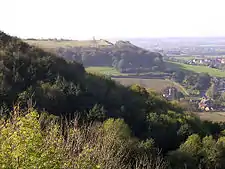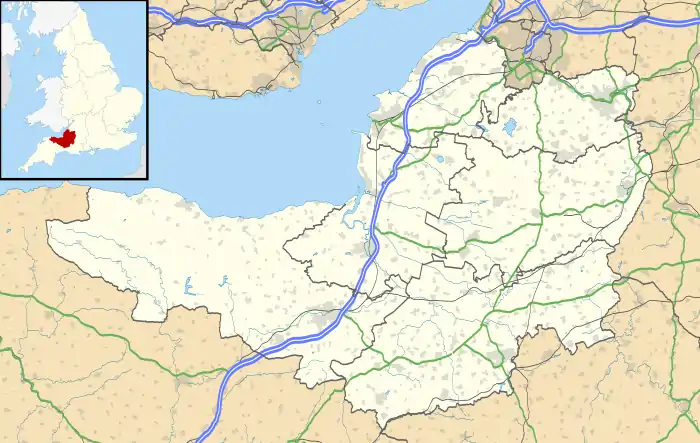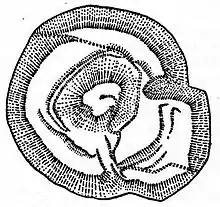Montacute Castle
Montacute Castle was a castle built on a hill overlooking the village of Montacute, Somerset, England.
| Montacute Castle | |
|---|---|
| Montacute, Somerset | |
 View from the site of Monacute Castle | |
 Montacute Castle | |
| Coordinates | 50.9493°N 2.7231°W |
| Grid reference | grid reference ST493169 |
| Type | Motte and bailey |
| Site information | |
| Owner | National Trust |
| Open to the public | Yes |
| Site history | |
| Battles/wars | 1068 uprising |
Details
Montacute Castle was built after the Norman Conquest of England in 1066 by Robert of Mortain.[1] The castle was part of a new settlement called Mons Acutus - literally, sharp hill - built on land that Robert had acquired from Athelney Abbey in exchange for the manor of Purse Caundle, an expensive exchange for Robert.[2] The natural features of the hill were used to form an oval-shaped motte and an inner bailey, surrounded by an outer bailey beyond.[3] A park for hunting was established alongside the castle and the village.[4]

The location for the castle is thought to have been a deliberate political statement by Robert: before the battle of Hastings, the Anglo-Saxons had discovered what they believed to be a holy cross on the hill.[5] Taken into battle by Harold Godwinson who held it in great esteem, "the holy cross" had also been used as the battle cry of the Anglo-Saxon army against the Normans.[5]
Robert made Montacute Castle the caput, or main castle, of his honour, abandoning another castle he built in Somerset, Castle Neroche.[6] The castle was unsuccessfully besieged in 1068 during a major Anglo-Saxon revolt against Norman rule, but the rebels were defeated by Geoffrey de Montbray, the Bishop of Coutances.[7] In 1102, however, William of Mortain (Robert's son) gave the castle and the surrounding lands to the Cluniac order, who founded Montacute Priory there.[8]
The castle was no longer of military value and was left to decline, although the castle chapel, dedicated to Saint Michael, continued in use until at least 1315.[9] The antiquarian John Leland described the castle in 1540 as "party fell to ruin", and by this period it was being quarried for its stone, ultimately resulting in its disappearance.[3] The castle chapel was eventually rebuilt after the destruction of the surrounding castle.[3]
Today the site is a scheduled monument.[10] An 18th century folly, St. Michael's Hill Tower, named after the castle chapel, stands on the site today, making use of part of the castle chapel's foundations.[11] The site is owned by the National Trust and is open to the public.[12][13] English Heritage staff surveyed the site for the National Trust in April 2000.[14]
References
- Richardson, p.3.
- Richardson, p.3; Pounds, p.68.
- Richardson, p.7.
- Richardson, p.8.
- Parishes: Montacute, A History of the County of Somerset: Volume 3 (1974), pp. 210-224, accessed 13 July 2011; Richardson, p.3.
- Pounds, p.64.
- Richardson, p.4; Liddiard, p.35; Mackenzie, p.63.
- Creighton, p.117; Richardson, p.4.
- Richardson, pp.4, 7.
- Richardson, p.7; Motte and bailey castle, Montacute, Somerset Historic Environment Record, Somerset County Council, accessed 14 July 2011.
- Richardson, p.7, citing Adkins and Adkins (1989).
- "St Michaels Hill, Montacute". National Trust. Retrieved 6 April 2018.
- "Outdoor Adventure". National Trust. Retrieved 6 April 2018.
- Montacute Castle, Pastscape National Monuments Record, English Heritage, accessed 14 July 2011.
Bibliography
- Adkins L. and R. A. Adkins. (1989) "Excavation on St. Michael’s Hill," Proceedings of the Somerset Archaeological and Natural History Society 133, pp. 125–129.
- Creighton, Oliver Hamilton. (2005) Castles and Landscapes: Power, Community and Fortification in Medieval England. London: Equinox. ISBN 978-1-904768-67-8.
- Liddiard, Robert. (2005) Castles in Context: Power, Symbolism and Landscape, 1066 to 1500. Macclesfield, UK: Windgather Press. ISBN 0-9545575-2-2.
- Mackenzie, J. D. (1896) Castles of England. New York: Macmillan.
- Pounds, Norman John Greville. (1994) The Medieval Castle in England and Wales: a social and political history. Cambridge: Cambridge University Press. ISBN 978-0-521-45828-3.
- Richardson, Miranda. (2003) English Heritage Somerset Extensive Urban Survey: an Archaeological Assessment of Montacute. Somerset: Somerset County Council.